That kind of a field is what manufacturer support fosters.
“We were fortunate to win the championship in 2015 (with Scuderia Corsa and Ferrari) in that class and it has been a lot of fun in that class. Now, with a Lexus this year, it’s my first experience with a front-engine car,” Bell explained.
GTD is IMSA’s slowest class, yet has the most competitors.
“You’re constantly dealing with faster cars trying to lap you as you’re in this fiercely competitive race within a race,” Bell said. “That keeps you pretty busy behind the wheel and I love it.”
As for driver classifications, Bell said, “I am a Gold driver, and I haven’t checked commodity prices lately, but I’ve heard gold is going up. Like all of these things (driver classifications) there seems to be some inaccuracies and that’s just part of the game.”
Bell drives for former IndyCar champion Jimmy Vasser, who owns teams in IndyCar and IMSA. Lexus teamed with Vasser this year and the move seems to be paying off.
“We’ve won a couple, but have slipped a little in the points lately to the No. 86 Acura (Michael Shank Racing).” said Vasser. “We’re in the hunt for the manufacturers’ championship, which is important to Lexus. We’re right in the middle of it.”
Vasser takes a more philosophical view of GTD and the driver rankings.
“It’s interesting. It’s different actually. It makes for good racing when you have different levels of drivers. It seems like the Silver and Bronze drivers are getting closer to the Gold and Platinum drivers, the Pros and Ams. The gap seems to be closer than what it was a few years ago,” Vasser said. “When you mix drivers with different skill sets, it seems to make the driving more interesting.”
Trent Hindman is one of those up-and-coming drivers. He drives one of Michael Shank Racing’s Acura NSX race cars. They recently wrapped up the GTD championship. It’s a challenge Hindman relished in just his first year on the team.
Shank has a history as an opportunity maker, evidenced by his alliance with Jackie Hinericher’s all-female team.
“There are a lot of unknowns for everybody,” Hindman astutely said. “Drivers, crews and mechanics —you don’t always know where you really stack up. Luckily, in the five or six years since I switched to sports cars in IMSA, there have been a lot of knock-on-wood good opportunities and I’ve tried to make the most of them.”
Hindman started racing motocross at a very young age but that ended when a close friend was seriously injured and his mother put the kibosh on anything with two wheels and dirt. His driving career turned to the typical progression from karts to the Skip Barber series and the Mazda Road to Indy.
That’s when he realized the “pickens” were limited and fiercely contested.
He saw more opportunities in sports car and capitalized on them. His goal was to get a GT ride for a major manufacturer. Hindman jumped into the deep end in the Continental (now Michelin) Tire Challenge in GS.
He got a full-time ride with John Edwards in a BMW and won the championship.
“I was scrapping around in the development categories in Lamborghini Super Trofeo to get noticed enough to get a GTD ride,” Hindman said.
Shank signed him up as the third driver at the 2018 Petit Le Mans and was obviously impressed. He called Hindman the next day and inked a 2019 ride.
All that glitters is Silver for driver Hindman. In addition to performing well at Petit Le Mans, Michael Shank just happened to be looking for a Silver driver in 2019. Hindman hopes his performance this year doesn’t bump him to Gold and perhaps out of a 2020 ride.
